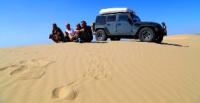Вы здесь
Nature reserve Small Barsuki.


Visiting the regional centers of Kazakhstan.
“Nature encourages no looseness, pardons no errors”
Ralph Waldo Emerson.
Tours and adventures in Kazakhstan.
State integrated nature reserve "Small Barsuki" is located in the Shalkar district of Aktobe region. The motives for organizing the integrated small nature reserve “Small Badgers” were the conservation of ecosystems of sand massifs with places habitats of populations of rare, endemic and relict species of flora.
Maintaining overall ecological balance of the region. The relief of the Small Barsuki reserve is depressed on the border of the highest part of the Turgai Plain and stretches from north to south with a strip of 2 to 15 km wide.
Relic sands are tuberous, semi-fixed by grassy and shrubby vegetation, the height of sandy hillocks is from 4 to 10 m, the slopes are gentle (up to 10 °). The hillocks are arranged randomly, sometimes elongated one after another, forming short chains.
The relief of the adjacent plains is hilly, the slopes of the hills have a steepness of up to 20 °, and in some places are cut by ravines and ravines. Absolute elevations from 100 to 150 meters. The climate is desert, sharply continental with high summer temperatures - average July temperature +25 + 26 ° С and moderately cold, very little snowy winter -13 ° C.
The average annual air temperature is + 6.9 ° С; the sum of temperatures is more than 10 ° С makes 3200 - 3500 °. The average annual rainfall is 120 - 140 mm, hydrothermal coefficient 0.3 - 0.4. The average annual wind speed is from 4 - 4.5 to 4.5 - 5.5 m / s, throughout the year east and north winds prevail.
There are no surface waters and the territory belongs to the inland drainage region. Water occurs only in drying streams, ravines during the melting snow and spring rains. On the outskirts of the sand massif there are small Shallow water lakes with salt water.
Groundwater: the depth varies from 1 - 4 m in the north, to 4 - 20 m in the southern part of the sands. 15 – 20 m along the loamy margins of sand and 1 – 4 m along saline depressions. Water-bearing sediments are represented by fine- and medium-grained sands thickness from 3 to 30 m, in the thickness of which groundwater lies at a depth of 0.5 - 1 m in depressions to 10 - 15 m under the hillocks.
In the zone of intense water exchange fresh water with salinity up to 1 g / l of calcium and sodium bicarbonate composition. In fixed sands, it increases to 1-3 g / l, the composition of sulfate sodium carbonate or sulfate. On the outskirts of the sand, mineralization reaches 5 - 10 g / l sometimes more.
The soil cover is represented by brown soils, desert alkaline, underdeveloped and hilly-ridged semi-fixed and loose sand. Brown soils are formed in elevated areas and between hills. Semi-fixed tuberous sands fine-grained, loose, little affected tillage process.
As the sand overgrows, they form on them desert sandy soil. In raw basins, meadow-alluvial soils are developed. By solonchak and takyr are developed on the outskirts of the sand. Vegetation: semi-desert, represented by herbs (wormwood, feather grass, Biyurgun) and shrubs.
In the sands, grass and wormwood prevail. IN shrubs are found in depressions and sands, saxaul prevails. The wildlife of the Small Badgers Wildlife Sanctuary makes up the desert complex Central Asian tortoise, gray and Caspian geckos, eared and round-headed pinworm, steppe agama, fast foot and mouth disease, sandy and eastern boa constrictor and arrow snake.
Along the sands along ancient runoff troughs, currently occupied by large area with salt marshes, one of the main migration routes of waterfowl and near-water birds. Among nesting birds, the steppe eagle, saker, and others are common. Of the mammals, the most numerous is the group of rodents.
Authority:
Natural resources of Aktobe region. Ecoproject LLP. 216 p.
Photos
Alexander Petrov.







